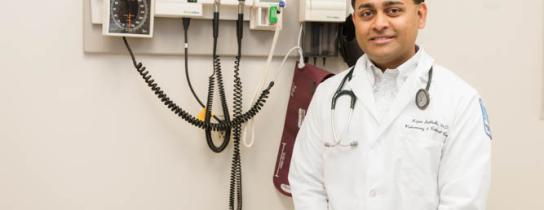
Lung Matters – A Four Part Series - Part Two
Welcome back readers,
In this edition, I’d like to discuss COPD, including the diagnostic approach to the disease and its classification. In the critical care topic, I briefly outline the role of noninvasive ventilation (ventilator support without leveraging a noninvasive artificial airway such as an endotracheal tube or tracheostomy tube) in various clinical situations and finally, I discuss sleep, caffeine and exercise, as promised last month.
Well, let’s start with some lung trivia to warm up:
- The lungs are the only internal organs that are constantly exposed to the environment.
- We breathe in > 2000 gallons of air every day. The lungs have the task of filtering and then oxygenating the blood that is pumped by the heart.
- Breathing is basically under involuntary control. Just thinking about breathing makes us decide to breathe. The brainstem controls the involuntary drive and the cerebral cortex exerts this need to breathe.
- Players of wind instruments have a higher lung capacity - FEV1 (forced expiratory volume) and FEF50 (Forced expiratory flow (FEF) is the flow (or speed) of air coming out of the lung during the middle portion of a forced expiration).
Go for GOLD:
GOLD stands for Global initiative for chronic Obstructive Lung Disease. Each year on November 15th, World COPD Day which is organized by GOLD to raise awareness and care of COPD, takes place. GOLD is a valuable resource to empower patients and educate health care personnel about COPD. They update guidelines after taking into consideration a large amount of data surrounding COPD and achieving international consensus.
Diagnosis:
- Spirometry, a common test to determine how well your lungs work, is required to diagnose COPD.
- The diagnosis of COPD is established by the combination of smoking history or environmental triggers, symptoms of cough, increased sputum, or shortness of breath, along with evidence of airflow obstruction, discovered through spirometry.
- The FEV1 (forced expiratory volume)/FVC (forced vital capacity) ratio is the amount of air exhaled in the first second, divided by all of the air exhaled during a maximal exhalation, which defines airflow obstruction (< 70%); although, lower limits for standard values have been advocated by others, based on variability in the distribution of normal values according to age, height, gender and ethnicity.
- FEV1 or in other words, your lung capacity, is the proportion of expirable air/vital capacity that can be forcefully expired in 1 second, to the full vital capacity.
- The severity of airflow limitation is ranked based on your FEV1 (lung capacity).
- FEV1/FVC ratio of < 70%, suggests that airflow obstruction is established.
- FEV1 > 80% is mild.
- FEV1 50-79% is moderate.
- FEV1 30- 49% is severe.
- FEV1 < 30% is considered very severe airflow limitation.
Explaining Non Invasive Ventilation (NIV):
As mentioned earlier, this is essentially a form of supporting the patient’s own breathing with carefully targeted positive pressure assist during different phases of breathing, applied via a snug fitting mask, in comparison to using an endotracheal tube that is required for invasive mechanical ventilation.
Commonly encountered modes are CPAP (continuous positive airway pressure), BiPAP or Bilevel (different pressure assist during inspiration and expiration) and a full-fledged NIV which mimics an invasive mechanical ventilator in terms of its capabilities, specifically to adjust respiratory breath volume, limit pressure, set rate, flow, cycling, etc.
Conditions that can be treated with a NIV in a hospital setting are reviewed below:
- OSA- Obstructive sleep apnea typically after a diagnosis is established by a sleep study.
- COPD (when there is retention of CO2, or when there is impending respiratory failure and in post-extubation scenario for patients with severe COPD).
- CHF- Congestive Heart Failure in an acute setting of acute pulmonary edema causing respiratory failure.
- There is a limited role for using NIV currently for asthma, aspiration pneumonia, drug overdose and ARDS (Acute Respiratory Distress syndrome) which is a severely hypoxemic type of respiratory failure.
- Severe respiratory acidosis with a PH < 7.1, poor mental status (except if secondary to hypercapnia), inability to protect airway, facial trauma, and ARDS are specific situations when to use NIV.
Sleep well, have a cup of Java and exercise!
Acute sleep loss can reduce the time to exhaustion during heavy exercise, as well as cause an increase in minute ventilation. Research is inconsistent regarding the effects of sleep deprivation and specific parameters of exercise, like VO2 max (the measurement of the maximum amount of oxygen that a person can leverage during intense or maximal exercise) and maximal exercise performance.
In a study of firefighters exploring the effects of sleep deprivation and simulated wildfire suppression, the sleep restricted group was found to be less physically active throughout the simulation. This suggests the alteration of behavior to conserve effort during rest periods, to be able to maintain performance during firefighting work tasks.
Coffee or a cup of Java or a cup of Joe, however you would like to call it, is an almost universally enjoyed beverage around the world. A cup of Java derives its name from the Indonesian island of Java, which was the largest producer of coffee at one point in time and was colonized by the Dutch who shipped the merchandise across the world. Caffeine has a beneficial effect on exercise is considered an ergogenic aid and is widely used by athletes. Moderate caffeine intake (1-2 cups of coffee or its equivalent in caffeinated beverages) prior to exercise, has been shown to increase exercise performance, endurance and maximal exercise capacity.
To summarize, ensure you have a good night’s sleep, enjoy a great cup of Java and then go for a run, ride your bike, play your sport or just do your thing!
Rajan Sadagopal K. Subbiah MD, is a Pulmonary and Critical Care Medicine Specialist and sees patients in Crystal Run's Newburgh and Rock Hill offices.

 Optum Radiology at Crystal Run Healthcare
Optum Radiology at Crystal Run Healthcare Request medical records online
Request medical records online